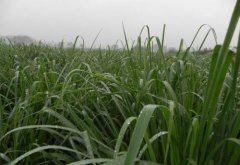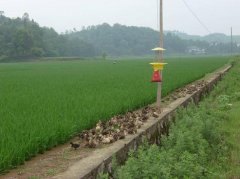What is organic rice? Planting and fertilization of Organic Rice in Organic planting Technology
The rice produced by planting the varieties recommended by the improvement farm without the use of chemical fertilizers, chemical synthetic pesticides, herbicides, growth regulators and so on is called organic rice. So how exactly do you plant it? If you want to eat real organic rice, it is best to grow it yourself. So let's take a look at how to plant it.
In order to cope with the impact brought by the opening of rice import after the government's entry into WTO, and to maintain our ecological environment, the government has implemented organic cultivation of rice, and has actively promoted organic cultivation of rice since 1984. The field began the experimental research on the method of organic cultivation of rice in the second phase of 1984, and the first phase in 1985 was planted in Xilu, Hutong, Huwei and Puzi townships with an area of about 7 hectares. in the second phase of 1985, it was planted in Taibao, Minxiong, Liuying and other townships, covering a total area of about 12 hectares. organic rice production and marketing classes were established in Xiluo, Litong, Huwei, Puzi and Taibao, with a total area of 63.94 hectares.
The fertilizer materials used in organic cultivation of rice can be used after full fermentation of wastes from farmers and livestock. The organic fertilizer materials used by each class in this area are different. The purpose of this experiment was to compare the effects of four kinds of organic materials, such as soybean meal, rapeseed meal, chicken manure compost and rice bran compost, on the yield, quality and taste of organic rice, and to compare their economic benefits, so as to provide reference for farmers. In addition, in order to explore the effects of continuous application of the above four kinds of organic materials on soil PH value, organic matter, available potassium content and whether there is heavy metal pollution or not, soil samples from each treatment area were taken for analysis after each harvest.

Organic matter used and its dosage
1.
Soybean powder: basic fertilizer soybean powder 2000 kg/ha, topdressing soybean powder 660 kg/ha.
two。
Rapeseed meal: basal fertilizer rapeseed meal 2400 kg/ha, topdressing rapeseed meal 800kg/ha.
3.
Chicken manure compost: base manure compost 12000 kg/ha, topdressing rapeseed meal 800 kg/ha.
4.
Rice bran compost: base compost rice bran compost 12000 kg/ha, topdressing rapeseed meal 800 kg/ha. The above treatments are converted to 160 kg of nitrogen fertilizer per hectare, of which 120 kg is base fertilizer and 40 kg is topdressing.
During the growth of rice, chemical fertilizers and pesticides were not used at all, and traditional pesticides were replaced by thurium, subtilis and soot in the prevention and control of diseases and insect pests. Husk mulching (10000 kg per hectare), Zhanshui treatment and artificial extraction were used to control the occurrence of weeds. The agronomic characters such as plant height, panicle number, yield per hectare, brown rice quality, white rice quality and edible quality of rice in each treatment area were investigated and soil analysis was carried out.
Effects of different organic materials on yield
In the second stage, the yield was the highest in rapeseed meal area and the lowest in rice bran composting area in 1987, the highest in soybean meal area and the lowest in rapeseed meal area in 1988, the highest in soybean meal area and the lowest in rice bran composting area in 1989. However, there was no significant difference in each year, and the average of three years was the highest in soybean meal area and the lowest in chicken manure composting area. In the first stage, the yield was the highest in rapeseed meal area and the lowest in rice bran composting area in 1988, the highest in chicken manure composting area and the lowest in rice bran composting area in 1989. However, there was no significant difference in each year, with the highest in chicken manure composting area and the lowest in rice bran composting area.
The results showed that different organic manure materials cultivated rice with the same amount of nitrogen fertilizer (160 kg per hectare), except that the yield of rice in the first stage of rice bran composting area was lower and reached a significant level, the yield per hectare of the other treatments did not reach a significant difference level. And there was no significant difference in other agronomic characters among different treatments (Table 2).
Effects of different Organic Materials on Rice quality
Rice quality includes volume weight, intact rice rate and damage rate. The volume weight of brown rice obtained from the application of four kinds of organic materials was more than 780 grams / liter in the two cropping stages, and as high as 796 grams / liter in the second cropping stage. The rate of intact rice is more than 65% of that of second-class rice, and the rate of first-stage cropping is as high as 79.7%. The victim rate was relatively high in the second stage, and the four treatments were all more than 20%, which may be due to the typhoon in 1988 and 1989. The first-stage cropping was relatively low, and the lowest rice bran composting area was only 9.8%. The dead rice was higher in the second stage, and the immature grain was higher in the first stage. The quality of white rice was tested by Taichung Agricultural improvement Farm, and the percentage of brown rice was more than 80% in the four treatments, more than 73% in the second stage, more than 71% in the first stage, and more than 67% in both stages. There was no significant difference among the four treatments. There was no significant difference in the appearance of rice grains. The transparency of rice grain appearance was 3.3 in the soybean meal treatment area and chicken manure composting area in the first stage, 3 in the rest, 1 in Xinbai stage 2, less than 1.6 in the first stage and 0 in the back white stage 2. The content of amylose starch was 19.1 ~ 19.6 (%) in the second stage and 17.3 ~ 17.7 (%) in the first stage. The crude protein content of the second stage was 7.27.6%, the first stage was 5.55.7%, and the gel extensibility second stage was 76.078 mm. There was no significant difference in these rice quality characteristics among different treatments in the same period, but there were great differences among different stages.
Effects of different organic materials on eating quality
According to the evaluation of rice taste function, the white rice cultivated with four kinds of organic materials in each stage was compared with the rice treated with rice bran compost as the control, and the rice with better overall evaluation than the control was given a positive score and a negative score compared with the control. the rapeseed meal area and soybean meal area were considered to be better.
Soil response after cultivation of different organic materials
The results of soil analysis after cultivation in different stages showed that the soil after organic cultivation was neutral and the content of organic matter was above medium. After five periods of organic cultivation, the contents of heavy metals in the soil were low in zinc, copper and nickel, medium in chromium, cadmium and lead, and uncontaminated.
Price of organic fertilizer per hectare for each treatment
58560 yuan in chicken manure composting area was the highest, followed by rice bran composting area 52560 yuan, soybean meal area 19995 yuan, rapeseed meal area 18240 yuan the cheapest.
The organic fertilizer price per hectare of chicken manure composting area was the highest, followed by rice bran composting area 52560 yuan, soybean meal area 19995 yuan, rapeseed meal area 18240 yuan. The taste of white rice with various organic fertilizers applied in different years was considered to be the best in soybean meal area and rapeseed meal area. In terms of yield, rice quality, taste performance and material price, rapeseed meal and soybean meal are the best materials for organic cultivation of rice in this area.
The results of the experiment showed that the average yield per hectare of rice in soybean meal area was the highest, 4109.9 kg in rapeseed meal area, 3994.9 kg in chicken manure composting area, 6309.6 kg in chicken manure composting area, 6306.2 kg in rapeseed meal area and 5866.8 kg in rice bran composting area. Except that the yield of rice bran composting area in the first stage was lower than that in other areas and reached a significant level, the yield per hectare of each treatment in other stages did not reach a significant difference level.
- Prev

Introduction to lemon citronella, the efficacy and function of lemon citronella
Lemon citronella was widely cultivated in Taiwan in the 1940s and 1950s to extract citronella oil for export. At that time, mint oil and camphor oil were one of the most important agricultural products for Taiwan to earn foreign exchange. After 1957, due to the technological development of chemical synthesis
- Next

Ecological Duck raising: introduction of New Technology and efficient Ecological Duck raising Technology in Paddy Field
The natural ecology is diversified and all kinds of creatures coexist harmoniously. We can raise a lot of animals in rice fields to increase our income. Let's take a look at how to raise ducks in the fields. And even under the beautiful ecology, there are also annoying problems for organic farms.
Related
- A one-day flower show brings 130 million yuan in orders! Nanhai, this Phalaenopsis exhibition is amazing
- What do the flower language and meaning of Lutheran tree mean? Precautions for planting Lutheran tree
- Encounter Chaoshan Kongfu tea, not without this cup of Phoenix single clump
- The durian market in Vietnam and Thailand is flooded. The price of imported durian has plummeted by 30-40% in a month.
- Shanghai solved the problem of local vegetable supply by planting 80,000 mu of green leafy vegetables.
- Wageningen University has become the best agricultural university in the world for the seventh time in a row.
- The strongest export season of South African grapes is full of challenges, with exports to Russia falling sharply by 21%.
- Sri Lanka is on the verge of bankruptcy, "Tea for debt" Organic Agriculture Revolution aggravates the Food crisis?
- Turning waste into earthworm manure and worm manure into organic fertilizer-A new choice for auxiliary farming
- Organic rice growers shoulder the responsibility of nurturing agricultural talents! Yinchuan Sustainable Farm with Organic Life Camp

